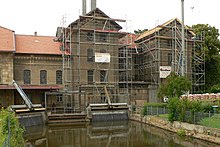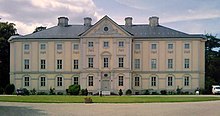Brüggen (Leine)
|
Bruggen
City of Gronau (Leine)
|
||
|---|---|---|
| Coordinates: 52 ° 2 ′ 34 " N , 9 ° 46 ′ 53" E | ||
| Height : | 94 m above sea level NHN | |
| Area : | 12.2 km² | |
| Residents : | 875 (Nov. 30, 2016) | |
| Population density : | 72 inhabitants / km² | |
| Incorporation : | November 1, 2016 | |
| Postal code : | 31028 | |
| Area code : | 05182 | |
|
Location of Brüggen in Lower Saxony |
||
|
Brüggen in the Hildesheim district
|
||
Brüggen is a district of the city of Gronau (Leine) in the district of Hildesheim , Lower Saxony (Germany).
geography
Brüggen is located north of Alfeld (Leine) between the Weserbergland and Harz an der Leine nature parks . The Seven Mountains rise east and south-east of Brüggen .
history
Place name
The old names of the place are 936 Brugheim , 954 Brugkihem , 955 Brugkiem , 965 Bruggeheim , 997 Bruggihem , 1004 Bruggeheim , 1210 Brugehem , 1220 Brucchem , 1226 Bruken and 1216 Brucken . Despite some variations, the basic form of the place name is easy to recognize. The name consists of a combination of “bruggi” for bridge and “-hem” for home. Therefore, Brüggen stands for home / settlement on the bridge.
middle Ages
The Brüggen was first mentioned in a document in 936. The later Emperor Otto the Great , son of the Saxon King Heinrich I, issued a total of four documents here at the Royal Court of Brüggen . With these he granted Bishop Balderich of Utrecht (Holland) the right to mint in 937 , approved the establishment of the Fischbeck Monastery on the Weser in 955 , confirmed the traditional diocese rights to Bishop Landward of Minden in 961 and transferred the right to mint to the brothers of the Moritz Church in Magdeburg in 965 and the market duty at Gittelde am Harz. His grandson, Emperor Otto III. gave the royal estate of Brüggen with Hemmendorf, Lehde and Banteln to the Essen monastery on the Ruhr in 997 . In 1039, Emperor Heinrich III. Brüggen to the Gandersheim Monastery , whose abbess Adelheid I was a daughter of Emperor Otto II and his wife Theophanu .
The von Steinberg family lived on Gut Brüggen from around 1180 , a castle is attested in 1207 and the local church is mentioned for the first time in 1220. In 1470 there were 6 Meierhöfe and 7 Kothöfe in Brüggen in addition to the manor . In 1505 the wooden church was replaced by a stone building, and in 1542 the Reformation was introduced in the Principality of Braunschweig-Wolfenbüttel .
Modern times
In the Thirty Years War Tilly's troops looted the place. In 1693 Friedrich von Steinberg had the current castle built.
From 1741 to 1852 there was a "Posthof" as a relay station in Brüggen, and from 1878 to 1963 a train station on the Hanover-Kassel line. The Brüggen volunteer fire brigade was founded in 1895 and has been providing fire protection and general assistance ever since . In 1909 Brüggen received a water pipe and a sewerage system. In 1965 the joint municipality of Brüggen was formed, which has been part of the joint municipality of Gronau since 1974.
Incorporations
On November 1, 2016, Brüggen was incorporated into the city of Gronau (Leine). The community was a member of the joint community of Gronau (Leine) .
politics
City Councilor and Mayor
Since November 1, 2016, Brüggen has been represented at the municipal level by the City Council of Gronau (Leine).
coat of arms
The municipality was given the coat of arms on May 23, 1937 by the President of the Province of Hanover . The district administrator from Alfeld presented it on January 21, 1938.
| Blazon : “Asingle-arched, red stone bridge on gold over a blue - silver corrugated shield base . From the bridge growing a black , rotbewehrter Adler (medieval imperial eagle) with spread wings . " | |
| Foundation of the coat of arms: According to folk etymology, the village of Brüggen takes its name from a number of bridges that cross the Leine and the sometimes very swampy terrain of its lowland. This idea is often expressed in symbols of the village and is therefore anchored in the coat of arms. During the time of the Saxon emperors, the place was of great political importance. The royal court of Brughem (= Brüggen) saw Otto the Great within its walls quite often , which is attested by a number of imperial documents that Otto carried out here. The earliest is dated around the turn of the year 936–937. This marked the beginning of the millennium celebration in 1937 and, on the other hand, the inclusion of the old imperial eagle in the upper part of the coat of arms. The coat of arms was first used in the seal on June 13, 1937, on the day of the millennium, by the mayor of the municipality of Brüggen. |
Culture and sights
museum
The Brüggen Local History Museum was opened in October 2001. It presents regional culture as well as nature and is looked after by a local homeworker on a voluntary basis. The museum has a larger collection of photos on Bruges as well as local literature. There are special exhibitions on local topics.
Brüggen Castle
Brüggen Castle, built in 1693 by Friedrich von Steinberg with castle park, castle church, courtyard and farm buildings, came into the possession of the Barons von Cramm in 1911 by way of hereditary path . The so-called tennis baron Gottfried von Cramm spent a large part of his youth here. He celebrated his wedding to Barbara Hutton here at great expense in the 1950s .
Castle garden
The castle garden in Brüggen comes from the age of absolutism. The baroque palace garden gave way to the English garden in the age of classicism and romanticism . Only the large oval lawn in front of the castle still reveals the extent of the baroque garden like a frame. Despite the disappearance of the splendor of the garden, the park of Schloss Brüggen with its landscape design, which optically incorporates the Leine valley into the garden design via visual axes, has remained a site worth seeing.
Village church
The village church of Sancta Maria ad septem montes comes from different construction phases. The organ installed by organ builder Müller in 1746 was replaced in 1904 by a pneumatic mechanism by Furtwängler. In 1960 Hans-Christian Drömann was pastor here.
traffic
Brüggen is connected to the road network via federal highway 3 , which is located in the immediate vicinity of the municipality to the west.
The Hannöversche Südbahn Hannover - Göttingen runs through the municipality. The next train station is in Banteln .
Personalities
Sons and daughters of the place
- Karl Lange (1811–1867), court stone mason and master bricklayer, founder of the Langesche Foundation
- Ernst von Steinberg (1848–1911), Prussian officer, landowner and member of the Prussian manor house
- Gottfried von Cramm (1909–1976), tennis player
- Norbert Klora (* 1955), artist
People connected to the place
- Johann Oswald Harms (1643–1708) painter, etcher and the first important baroque stage designer, he painted the ceiling frescoes in Brüggen Castle
- Hermann Korb (1656–1735), builder of the Baroque era, he built Brüggen Castle in 1693
- Johann Balthasar Lauterbach (1663–1694), mathematician, architect and ducal-Braunschweig master builder from 1688 to 1694, he provided the design for Brüggen Castle
- Burghard von Cramm (1874–1936), manor owner and court official, lord of Brüggen
- Hans-Christian Drömann (1932–2018), Lutheran theologian, regional superintendent for the Lüneburg district of the Evangelical Lutheran regional church of Hanover, abbot of the Amelungsborn monastery, pastor in Brüggen
literature
- Heinz-Joachim Tute: Historical gardens in the Hildesheim district. In: Yearbook 1996 of the district of Hildesheim , pp. 146–148
Web links
Individual evidence
- ↑ 100 Population update - based on the 2011 census. In: Website of the State Office for Statistics Lower Saxony. Retrieved on November 9, 2018 (Area column, as of January 1, 2015).
- ↑ Population of the Leinebergland - Barfelde community. (PDF; 3.5 kB) In: www.vennekohl.de. November 30, 2016. Retrieved November 9, 2018 .
- ^ Jürgen Udolph (research): The "place name researcher". In: website NDR 1 Lower Saxony . Archived from the original on December 28, 2014 ; accessed on March 18, 2018 .
- ↑ Lower Saxony State Chancellery (Ed.): Law on the unification of the communities of Banteln, Betheln, Brüggen, Despetal, Rheden and the city of Gronau (Leine) as well as on the new formation of the Duingen area and the Leinebergland community, Hildesheim district . Lower Saxony Law and Ordinance Gazette (Nds. GVBl.). No. 22/2015 . Hanover December 15, 2015, p. 399-400 ( digitized [PDF; 278 kB ; accessed on June 29, 2019] pp. 17–18).
- ^ A b Wilhelm Barner : Coat of arms and seal of the Alfeld district . Rebinding. Lax GmbH & Co. KG, Hildesheim 1998 ( digitized version of the text part of the first edition from 1940 [PDF; 10.0 MB ; accessed on June 10, 2019]).
- ↑ a b Coat of arms of the municipality of Brüggen. (PDF; 58 KB) In: Website of the Samtgemeinde Gronau (Leine). Retrieved June 10, 2019 .
- ↑ Wolff Carl A. v. Behr, U. Hölscher: The Art Monuments of the Province of Hanover, Volume 2, Issue 10, 1939, p. 20.
- ^ Gisa Bauer: Evangelical Movement and Evangelical Church in the Federal Republic, 2012, p. 731.







